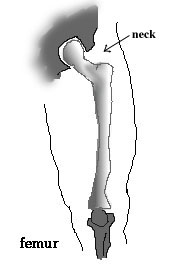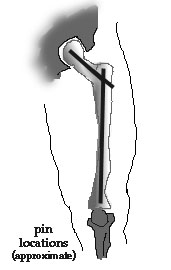








I first began experiencing symptoms when I was nine years old. I complained to my parents of pain and weakness in my left leg. They were not sure what was wrong or if it was anything to worry about, but it continued to worsen over the next couple of years and started interfering with my ability to run and walk. Finally they took me to a series of specialists. I went through a bunch of different tests, including a radioactive tracer study and some MRI scans. Eventually they found a doctor who specialized in pediatric orthopedics and had treated other patients with fibrous dysplasia. As it turned out, he was the only doctor in Anchorage, Alaska (where I lived), who was experienced with the surgery I needed. Otherwise, I would have had to go to Seattle for treatment.
 Fibrous dysplasia is formally considered a "tumor," though it is benign and non-cancerous. Like certain cancers, the main thing the cells are doing wrong is that they're producing the wrong kind of tissue in the wrong place. Fibrous dysplasia tissue is fibrous (hence the name) and gristly, forming a spongelike mass quite unlike normal bone. On X-rays it appears darker than regular bone and has a distinctive honeycomb-like look, which has been referred to as a "ground glass matrix." Spindles of sharp bone also form in the matrix of fibrous tissue and irritate the bone marrow and other soft tissue, causing some of the chronic pain associated with some cases of fibrous dysplasia. Another cause of pain are stress fractures which occur frequently because the fibrous tissue is soft and brittle.
Fibrous dysplasia is formally considered a "tumor," though it is benign and non-cancerous. Like certain cancers, the main thing the cells are doing wrong is that they're producing the wrong kind of tissue in the wrong place. Fibrous dysplasia tissue is fibrous (hence the name) and gristly, forming a spongelike mass quite unlike normal bone. On X-rays it appears darker than regular bone and has a distinctive honeycomb-like look, which has been referred to as a "ground glass matrix." Spindles of sharp bone also form in the matrix of fibrous tissue and irritate the bone marrow and other soft tissue, causing some of the chronic pain associated with some cases of fibrous dysplasia. Another cause of pain are stress fractures which occur frequently because the fibrous tissue is soft and brittle.
On X-rays my femur looks dark and fibrous from just above the kneecap all the way up to the head of the femur, where it rests in the socket of the hip. The hip is one of the worse places to have the disease (besides the skull and spine) because the neck of the femur is weak (see ineptly homemade diagram to right) and bends under continual stress and pressure. Eventually it will melt into what is called a "shepherd's crook deformity," because instead of coming up to the socket, the neck of the femur is bent in a hook like a shepherd's crook. This would have shortened my leg by about 3 inches.
 Eventually problems started to arise again, in the form of increased pain and disability. It turned out what was happening was that the pins, which had been inserted when I was eleven, were not strong enough to support my adult weight. They were bending under my weight, and thus the bone was bending as well in an outward curve. The solution was to remove the original pins and replace them with a thicker rod (other diagram), about as big around as my finger and running the whole lenght of the femur, in a 7(?)-hour surgery. Locking screws held the rod in place, and a shorter rod reinforced the neck of the femur. The bone was also cut and repositioned to reduce the curve that had developed and add a little bit of length to my leg. (It is now about 1/2 inch shorter than the other, as opposed to close to 1" before surgery.)
Eventually problems started to arise again, in the form of increased pain and disability. It turned out what was happening was that the pins, which had been inserted when I was eleven, were not strong enough to support my adult weight. They were bending under my weight, and thus the bone was bending as well in an outward curve. The solution was to remove the original pins and replace them with a thicker rod (other diagram), about as big around as my finger and running the whole lenght of the femur, in a 7(?)-hour surgery. Locking screws held the rod in place, and a shorter rod reinforced the neck of the femur. The bone was also cut and repositioned to reduce the curve that had developed and add a little bit of length to my leg. (It is now about 1/2 inch shorter than the other, as opposed to close to 1" before surgery.)
The way they found out about the problem was because I broke my leg a second time, so between that and the recovery from surgery I wound up being on crutches for over a year (the longest time so far). However, except for a minor surgery to remove two locking screws that had begun to back out two years ago, I have been on my feet ever since.
The life experiences that others have shared with me have made me wonder how accurate this really is...The guy's a pediatric specialist, after all, so most of what he knows is concerned with FD in kids, not adults. I have heard from several people who developed the disease in adulthood and have noted no lessening of symptoms. There's so much we don't know.

Get your own Free Home Page